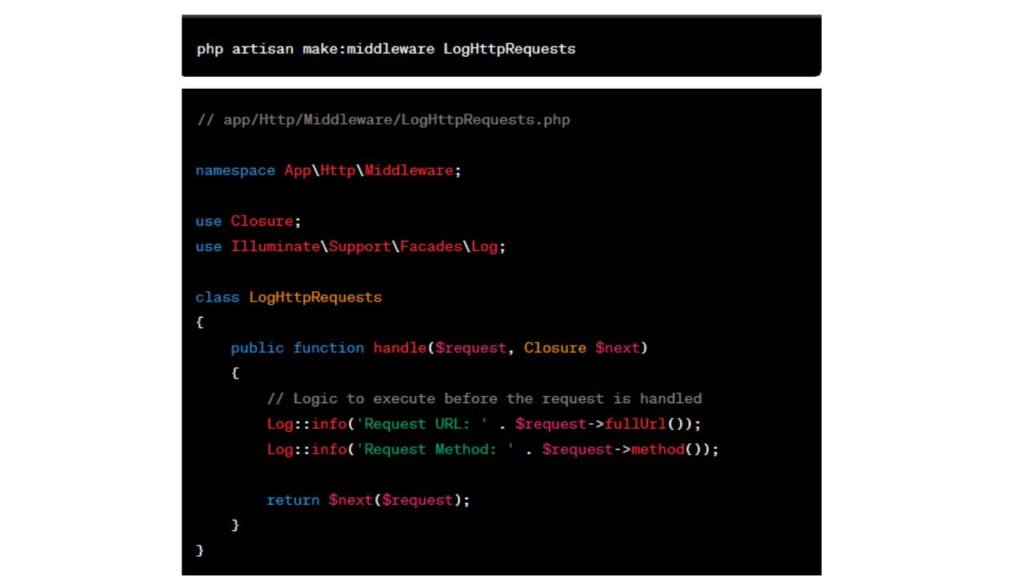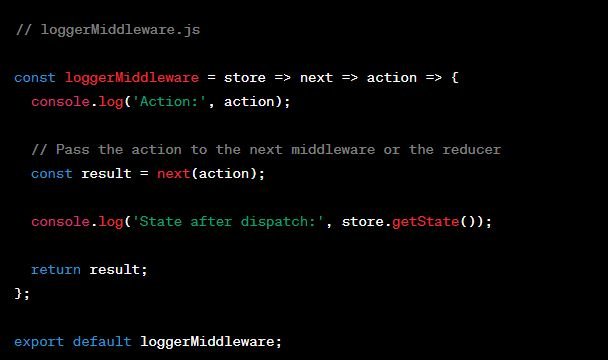Middleware is a crucial concept in Software Development, particularly in web applications. it refers to a piece of software or a function that sits between different parts of an application, allowing them to communicate or enabling additional functionalities. In essence, middleware intercepts the communication flow between components and performs specific tasks actions.
The Role Middleware Plays
- Intermediary Role: Middleware acts as a bridge between different components of an application, such as between the client and the server, or between different layers of software.
- Functionality Extension: It extends the functionality by adding features or performing tasks like authentication, logging, error handling, and data transformation.
- Reusability: Middleware is ioften designed to be reusable across different parts of an application or even across multiple applications.
TYPES OF MIDDLEWARE
- Application Middleware: Operates within the application and handles requests and responses. Examples include authentication, Logging, and Error Handling.
- Server Middleware: Executes at the server level and manages the interaction between the client and the server. it can handle routing , caching etc.
- Database Middleware: Acts as an Interface between the application and the database, managing database connections, transections and queries.

In this example ‘app.use()’ is used to register a middleware function that logs information about the incoming request. The ‘next()’ function is called within middleware to pass control to the next middleware function or the route handler.
Benefits of Middleware
- Modularity: Enables the breaking down of functionalities into smaller, manageable parts.
- Flexibility: Allows for easy addition or removal of functionalities without impacting the entire application.
- Customization: Provides a way to customise components.
Middleware plays a vital role in structuring applications, enhancing their functionalities and enabling smoother communication between various parts of the application.
More Examples of Middleware are:
Django: In Django, middleware allows modifying request and response objects. Examples include:
- Authentication Middleware: Handles user authentication
- Session Middleware: manages session data for users.
- Security Middleware: Implements security features.

- The
RequestLoggerMiddlewareis a class that defines the custom middleware. - It takes
get_responseas an argument, which represents the next middleware in the chain or the view if this is the last middleware. - The
__call__method is invoked for each request. - You can perform any logic before and after the view processing.
This example demonstrates a simple middleware that logs information about incoming requests. You can modify or extend it to perform various tasks like authentication, modifying request headers, handling exceptions, etc., based on your application’s needs.
Laravel
Laravel uses middleware for filtering HTTP requests. Some examples include:
- Auth Middleware: Verifies user authentication before accessing routes.
- Cors Middleware: Handles cross-origin resource sharing.
- Logging Middleware: Logs request information for debugging.
Here’s a snippet code of how Laravel Middleware is implemented.

This will create a middleware file named LogHttpRequests.php in the app/Http/Middleware directory.
Open LogHttpRequests.php:
Register Middleware:
To use this middleware, you need to register it in the $middleware array within the App\Http\Kernel class.
Open App\Http\Kernel.php:

- The
handlemethod in the middleware receives the incoming request. - You can perform any logic you want before the request is handled.
- In this example, it logs information about the incoming request using Laravel’s
Logfacade. - The
return $next($request);line passes the request to the next middleware in the pipeline.
This example demonstrates a simple middleware in Laravel that logs information about incoming HTTP requests. You can modify this middleware to perform various tasks like authentication, manipulating request/response, etc., based on your application’s requirements.
ASP.NET Core
- Authentication Middleware: Authenticates users for protected routes.
- Routing Middleware: Directs incoming requests to the appropriate endpoint.
- Error handling Middleware: Handles exceptions and error responses.
Here’s a snippet code of how ASP.NET middleware is implemented.
Create a new class for your middleware:

Register Middleware:
In the Configure method of your Startup.cs, register your middleware:

- The
RequestLoggingMiddlewareclass contains the middleware logic and implements theInvokemethod, which is where the HTTP request is processed. - The
ILoggerinstance allows you to log information using ASP.NET Core’s logging framework. Invokemethod is where you can perform any logic you want before and after the request is handled.app.UseMiddleware<RequestLoggingMiddleware>();registers the middleware in the application pipeline.
This example demonstrates a basic middleware in ASP.NET Core that logs information about incoming HTTP requests. You can modify this middleware to perform various tasks like authentication, exception handling, etc., based on your application’s requirements.
Redux
In redux, middleware intercepts dispatched actions and can perform tasks like logging, asynchronous actions or modifying actions before they reach reducers.
Examples Include:
- Logging middleware: Logs dispatched actions and state changes.
- Thunk middleware:
- Enables asynchronous actions in Redux.
- Saga middleware: Handles side effects and asynchronous actions using generators.
Here’s a snippet code of how the Redux middleware is implemented.
Create a Logging Middleware:

Implement Middleware in Redux Store:

- The
loggerMiddlewareis a function that takesstoreas an argument and returns a function that takesnextas an argument, which in turn returns a function that takesactionas an argument. - It logs the action and the state before and after the action is dispatched.
- The
applyMiddlewarefunction from Redux is used to apply the middleware to the store.
This is a basic example of a logging middleware in Redux. Middleware can be used for various purposes such as asynchronous actions, routing, authentication, etc., and can be composed together for complex behavior.
Kubernetes (container Orchestration System)
In kubernetes, middleware-like functionality is provided by:
- Ingress Controllers: manage Incoming traffic, perform SSL termination, and routing.
- Service Meshes: Offer advanced networking features like traffic management, Security and Observability.
Here’s a snippet code of how Kubernetes Middleware is Implemented
In Kubernetes, middleware-like functionalities are implemented through various components like Ingress Controllers and Service Meshes (e.g., Istio) that manage and handle network traffic, routing, and other features. Let’s focus on an example using an Ingress resource in Kubernetes:
Kubernetes Ingress Controller:
An Ingress Controller manages external access to services in a Kubernetes cluster. Here’s an example using Nginx as an Ingress Controller:
Define an Ingress Resource:
Create an Ingress resource to handle HTTP traffic:

In summary, Middleware exists across various frameworks and systems, serving different purposes like authentication, logging, request handling, and more. Their flexibility allows for customisation and extensibility in various software architectures.





canada pharmacy reviews
https://expresscanadapharm.shop/# buying from canadian pharmacies
best rated canadian pharmacy
clomid 50mg for sale can i buy cheap clomid can i get cheap clomiphene without prescription where can i get generic clomid tablets can you buy clomiphene prices order generic clomid pills can i purchase cheap clomid online
I couldn’t hold back commenting. Profoundly written!
More posts like this would make the blogosphere more useful.
azithromycin order online – brand ciplox order flagyl 400mg online cheap
semaglutide oral – buy generic semaglutide online cyproheptadine order
cheap domperidone – purchase tetracycline buy generic flexeril for sale
inderal us – inderal over the counter methotrexate 2.5mg drug
amoxicillin online buy – buy generic diovan purchase ipratropium for sale
buy zithromax without prescription – order nebivolol 20mg online nebivolol where to buy
augmentin 625mg for sale – atbio info ampicillin canada
order nexium 40mg online cheap – anexa mate nexium medication
order warfarin online – https://coumamide.com/ order losartan 25mg
purchase meloxicam without prescription – https://moboxsin.com/ mobic tablet
prednisone 20mg uk – aprep lson prednisone 10mg for sale
buy ed pills generic – buy ed pills uk buy erectile dysfunction meds
order amoxicillin sale – https://combamoxi.com/ amoxil online buy
how to get diflucan without a prescription – https://gpdifluca.com/# diflucan 100mg canada
cenforce 50mg uk – https://cenforcers.com/ cenforce 50mg generic
canadian pharmacy ezzz cialis – https://ciltadgn.com/# canada cialis for sale
canadian cialis no prescription – https://strongtadafl.com/# cialis free trial phone number
buy zantac 300mg without prescription – online buy zantac 300mg sale
buy sildenafil 50mg – viagra sale usa buy generic viagra online
This website absolutely has all of the bumf and facts I needed there this case and didn’t positive who to ask. this
This website exceedingly has all of the low-down and facts I needed there this subject and didn’t comprehend who to ask. https://buyfastonl.com/amoxicillin.html
This is the description of topic I take advantage of reading. https://ursxdol.com/propecia-tablets-online/
I’ll certainly bring back to read more. https://prohnrg.com/product/acyclovir-pills/
The thoroughness in this section is noteworthy. stromectol gale
The thoroughness in this draft is noteworthy. https://ondactone.com/spironolactone/
I am in point of fact enchant‚e ‘ to glitter at this blog posts which consists of tons of useful facts, thanks representing providing such data.
ozobax without prescription
Greetings! Jolly serviceable recommendation within this article! It’s the little changes which liking turn the largest changes. Thanks a quantity for sharing! https://sportavesti.ru/forums/users/ichnu-2/
buy forxiga 10 mg – buy cheap dapagliflozin purchase forxiga generic
xenical over the counter – https://asacostat.com/ buy orlistat 120mg
The sagacity in this serving is exceptional. http://bbs.dubu.cn/home.php?mod=space&uid=405343
You can protect yourself and your ancestors close being wary when buying medicine online. Some pharmacopoeia websites manipulate legally and offer convenience, secretiveness, bring in savings and safeguards to purchasing medicines. buy in TerbinaPharmacy https://terbinafines.com/product/reglan.html reglan
Greetings! Jolly useful par‘nesis within this article! It’s the scarcely changes which liking turn the largest changes. Thanks a a quantity for sharing! site
More delight pieces like this would create the web better.
Downloaded the bet917app and it’s surprisingly smooth. Works a treat on my phone. Everything you need in your pocket, right? Get it here: bet917app
Giving a shot at 234vip22. Website looks clean and is easy to understand. Seems promising, will update after I’ve played a bit more. Go see for yourself at 234vip22.
Just deposited some funds into 79bet9, ready to roll! Nice welcome bonus to boost things up. 79bet9!